PinotFile: 6.24 April 30, 2007
|
Benovia Winery DebutsWhen I recently visited the Russian River Valley for the Hospices of Sonoma, I hung out with general manager Bob Mosby and winemaker Mike Sullivan of Benovia Winery. I came away very impressed by the commitment to precision viticulture, the state-of-the-art winery, and the deft winemaking here.. Benovia is still a secret to even the most avid pinotaficionados since the winery has yet to release a Pinot Noir (the inaugural Pinot Noirs will be introduced at this time next year). My barrel sampling of the 2006 vintage of Pinot Noirs indicated that this winery is poised for success. The new venture is spearheaded by a group of businessmen headed by Joe Anderson, who resides in Phoenix, Arizona, where his company, Schaller Anderson, Inc., is a third-party administrator for health insurance. He has a passion for fine wine and has committed significant financial resources to achieve his goal of making extraordinary wines. The winery is managed by Bob Mosby, PhD, a noted psychologist and business consultant who formerly lived in Phoenix . Bob is a long-time wine enthusiast who helped out with the crush at Williams Selyem beginning in 1989. After the winery was sold, he worked the harvest at Brogan Cellars. Well-known viticulturist Daniel Roberts, PhD, has been hired to oversee the management of the vineyards and direct all new planting projects. Joe Anderson searched for a winemaker that “had experience and touch to produce wines that are compelling, honest and dramatic.” The winemaker he chose was Mike Sullivan, a graduate of Fresno State who has worked in the wine industry for over 15 years. Most recently, he crafted refined and elegantly-styled Pinot Noirs at Hartford Family Winery in Forestville. Under his leadership, Hartford became one of California’s top producers of Pinot Noir, Chardonnay, and oldvine Zinfandel. Mike has received a number of accolades including “2002 Wine Personality of the Year” by Robert Parker of The Wine Advocate and “2002 Winemaker of the Year” by Ronn Wiegand of Restaurant Wine. After his hiring, Mike said, “I joined Benovia to make wines that transcend varietal correctness. I want to create bottlings that meld the grape, climate and topography into something unique and special. We’ve got some of the world’s finest cool-climate sites within spitting distance of our winery. The cold winds that blow off the Pacific Ocean and the complex soils and geography of the California coastline provide us with some of the greatest natural resources on Earth. I am looking forward to vinifying wines that are deep, concentrated and incredibly complex.” Bob and Mike are too of the nicest guys you ever want to meet. I urge you to visit the winery and get to know them. The vest brigade is pictured below (Bob on left, Mike in middle). 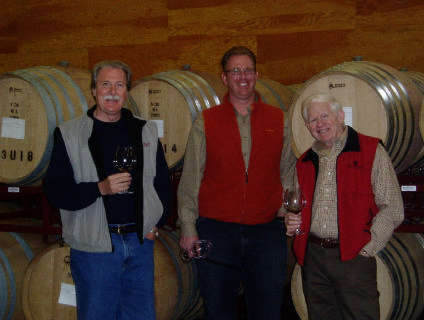 The winery is located on Hartman Road in Santa Rosa, in the heart of the Santa Rosa Plain. Originally, the building (pictured below) was the home of Merry Edward’s first winery, Merry Vintners. It was subsequently acquired by De Loach and expanded to produce nearly 30,000 cases. Joe acquired the 55-acre property from Cecil DeLoach. The winery has been downsized and equipped with the latest in winemaking toys. The Martaella Vineyard, now Benovia Vineyard, is adjacent to the winery. This vineyard is 18 acres, with 13.5 acres planted to the Pommard clone of Pinot Noir in 1998. Extensive renovation has been done to lower yields for quality. In addition, new tight-spaced plantings (4’ x 4’) are going in as I write this newsletter. The property also has a guest house (more about that later) and an additional house which will be converted into a hospitality center in the future. See additional photos on page 3. 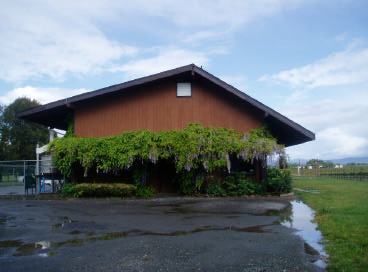
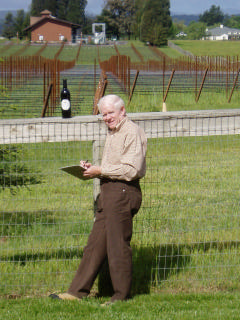 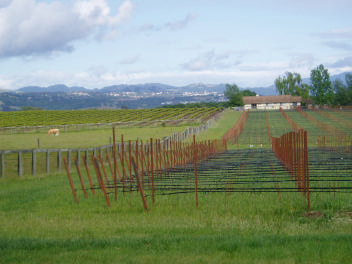 Above left: taking notes with new planting and winery in background. Above right: new plantings with guest house in far distance. In addition to the Benovia Winery and vineyards, owner Joe Anderson purchased the Benovia Ranch, formerly the Cohn Ranch in 2002. Bob took me for a drive to visit this magnificent 55-acre property. The Cohn Vineyard is located in the hills off of Westside Road, west of Healdsburg. It is one of the Russian River Valley’s heritage vineyards, with Pinot Noir and Zinfandel vines dating to 1975. Two women owned the property initially and it was subsequently sold to the Cohn family. For several years it was owned and farmed by De Loach Vineyards. The vineyard sits on a steep and rocky slope surrounded by redwoods and has a stunning view of the Russian River Valley (photo below). 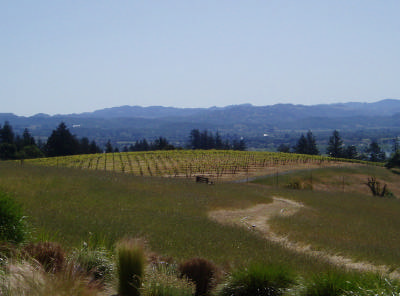 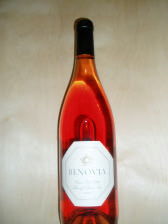 I barrel tasted through the 2006 lineup of Pinot Noirs and one 2006 Chardonnay. The Chardonnay was sourced from a former apple orchard in the Russian River Valley and I could swear that I tasted apple notes along with citrus flavors in this perfectly fine wine. There were two Pinot Noir blends: one an entry level wine from several vineyards and the second a blend of three vineyards. The latter was a step up with attractive aromatics and a long finish. The Cohn Vineyard Pinot Noir was ridiculous - generously perfumed and sensuous. There was a great core of intense cherry fruit, cola and spice, a silky texture, and a clean finish. The Savoy Vineyard (Anderson Valley) Pinot Noir exhibited a more characteristic structured and tannic backbone with nice herbal overtones on the backend. All of the wines were well-made with pin-point balance and appealing textures. No alcohol or tannic overload whatsoever. Mike says his style is “Old Word meets New World halfway.” The Benovia Vineyard Hideaway is a three bedroom, two bath house surrounded by vineyards at the end of Hartman Road. From every window there is a vineyard view. It is modern inside with plush bedding (I stayed a week with the Princess and we slept like babies here). The house has many amenities including a two-car garage, barbeque, spa, two porches, and even a fenced-in dog run. Perfectly located, the house is 15 minutes from both Healdsburg and Sebastopol and very close to the famous wineries of the Russian River Valley. I very highly recommend it for your adventures in Pinot Noir heaven. 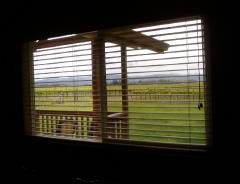 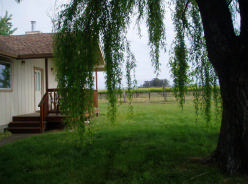
A Brief History of Vitus Vinifera in the AmericasThe heritage of grapevines goes back 20,000 years and grapes are man’s oldest cultivated crop. The Bible notes that Noah was the first to plant a vineyard. Grape seeds have been discovered in the tombs of the Egyptian Pharaohs and in ancient cave dwellings. All grapes belong to the genus Vitis and the most important species of this genus for fine wine is Vitis vinifera (often referred to as the European or wine grape). Wild grapevines are actually weeds, and differ from cultivated (European) vines by having flowers that are either all male or all female and cannot self-pollinate. The majority of cultivated grapevines are hermaphroditic (also known as ‘perfect” because each flower contains both male and female structures) and fertilize themselves. It is estimated that there are 10,000-15,000 different Vitis vinifera grape varieties. Early explorers spread Vitis vinifera to the Americas. Columbus brought the vine on his voyages which are said to have thrived in Haiti. In 1607, English colonists arrived at the shoreline of Virginia and found wild grapevines growing profusely. The first wine in the New World was made at Jamestown in 1608 with native scuppernong grapes. (I have also read that the first wine made in American was in Jacksonville, Florida about the same time). It was described as “foxy” and not compatible with British palates. Captain John Smith said, “(There are) “vines in great abundance in many parts that climbe the toppes of the highest trees. Of hedge grapes, we made neere 20 gallons of wine, which was neare as good as your French British.” Lord Delaware introduced the first European grapevines to the North American mainland in 1619. The colonists had abandoned efforts to make palatable wine with native grapes, and the French grapes could not be sustained in the colonies. Several obstacles presented themselves including the warm Virginia summers and the grapevines’ susceptibility to phylloxera and other diseases. In the early 1700s, new efforts in York County indicated that native grapes were the best choice for Virginia wines. Thomas Jefferson, after his purchase of Monticello, planted native grapes and spent more than 30 years producing wine, believing that it was good for both health and the enjoyment of dining. In 1774, Thomas Jefferson, George Washington, Peyton Randolph and George Mason were among the thirty-seven original subscribers of American’s first wine company - The Virginia Wine Co. The first European varietals were brought into California in 1767 by Spanish Padres from Mexico who established a chain of missions from San Diego to Sonoma from 1767 to 1833. It is thought that the first grapevine planted in California was the Criolla or Mission grape which produced wines of only modest quality. Extensive importation of European cuttings in the 1850s and 1860s created a home for European grapevines in California. Nearly all Virginia vineyards were neglected and abandoned during the Civil War of the 1860s. Prohibition effectively killed all remnants of a Virginia wine industry. In 1976, an Italian winemaker sent his vineyard manager to Charlottesville to produce European wines and the modern renaissance of Virginia wine began at what is now Barboursville Vineyards. There are now 119 wineries in Virginia, double that of ten years ago. Virginia has had success with Viognier, Cabernet Franc, and Norton. Norton grapevines, discovered in the 1820s by Dr. Daniel Norton of Richmond, are the oldest cultivated American grape in this country. Hybrid grape varieties were introduced in the northeastern part of North America in the 1950s to solve the viticultural challenge of cold and humid wine regions. Hybrid grapes are for the most part created artificially by crossing two different Vitis species (Vitis vinifera varieties are a result of crossings between grape varieties of the same species). Examples of hybrid grapes include Concord and Niagara (species Vitus labrusca), Chaunac, Baco Noir, Morochal Foch, and Videl.
Chilean Pinot NoirChile is located on the western coast of South America and bordered by the Pacific Ocean to the west and the Andes Mountains to the East. The climate in Chile’s wine-growing regions is similar to that of California’s Napa Valley and Bordeaux. Production is roughly 25% of Argentina’s, and Chile is best known for blended reds (Cabernet Sauvignon, Merlot, Carménère, Peitit Verdot and Cabernet Franc) and single-varietal wines of Carménére, Cabernet Sauvignon, Merlot, Syrah, Sauvignon Blanc, Riesling and Chardonnay. About 75% of Chile’s wine output is exported, primarily to the United States and United Kingdom which eagerly snap up Chile’s value-priced wines. For several years, Chile has been a source of low-priced Pinot Noirs, but recently there are a few producers in Casablanca, Calchagua and San Antonio Valleys that are making first-rate Pinot Noirs. Chile has followed the historical progression of California in that early on Pinot Noir was planted in the wrong places (such as the Casablanca Valley floor), over cropped, and vinified like Cabernet Sauvignon. Vintners are now discovering the best cool climate sites and planting the proper clones. Since 1999, Chileans have been reducing yields and focusing on small production, quality-driven Pinot Noirs. The amount of Pinot Noir vineyard acreage in Colchagua nearly tripled between 1997 and 2004.  Adolfo Hurtado has been the winemaker at Cono Sur from the beginning. His resume includes work at Domaine Jacques Prieur in Burgundy so he is well-suited to head the Pinot Noir program at this winery. Grapes are sourced not only from plantings in Colchagua Valley, but also San Antonio and Casablanca. Three Pinot Noirs are primarily exported: Southern Cone is from the Colchagua and Central Valleys that is very reasonably priced, Vision is a step up in quality and price, and the higher-end Pinot Noir is the Limited 20 Barrels ($25). Cono Sur’s top Pinot Noir is Ocio.
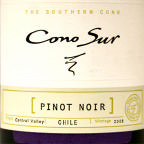 2005 Cono Sur Southern Cone Central Valley Pinot Noir Chile 14.0% alc., $8. · A light-bodied un-oaked wine with fruity aromatics highlighted by smoke. Nice and sweet dark cherry, raspberry and strawberry fruit on the palate with frisky acidity. Phenolic bitterness dominates the finish.
2005 Cono Sur Vision Colchagua Valley Pinot Noir 14.0% alc., $12. · This Pinot Noir is sourced from 78-year-old vines. Plenty of air time is required to smooth this wine out. It is light and soft with some attractive spiced cherry flavors and plenty of earthiness. There is prominent oak from start to finish and a lively acid spine. The plentiful funk in the nose and finish might appeal to Burgundy lovers who admire kinky wines.
Other Chilean Pinot Noirs to seek out: Matetic Vineyards The Matetic Family has owned this winery located in the San Antonio Valley since 2001. The labels read EQ for Equilibrium, not Matetic Vineyards. Winemaker Rodrigo Soto was trained in New Zealand and California. Consulting winemaker Ken Bernards, who has produced Pinot Noir for many years under the Ancien label, was involved in the development of the Pinot Noir program here.  Kingston Family Vineyards Courtney Kingston has turned a portion of her family’s Chilean cattle ranch in Casablanca Valley into a vineyard and focuses on Pinot Noir and Syrah. Byron Kosuge, formerly of Saintsbury and now making wines under his own B. Kosuge label, is the consulting winemaker and a partner in the project. Kingston has 77 acres of Pinot Noir planted and a new winery on site. This is one of Chile’s few gargiste wineries and plans are to keep production in the 500 case range and sell off the remaining grapes from the vineyard. Two Pinot Noirs are produced: Alazan ($28) and Tobiano ($18), names inspired by favorite horses of the past. Viña La Misión This winery is located on the site of an 18th century French mission station on the banks of the Rio Clarillo in the Maipo Valley. Vineyards are at various sites in the higher Maipo Valley and the Curicó Valley. William Fèvre, of Chablis fame, is closely involved with winemaking here. Piedra Feliz Pinot Noir is produced from fruit grown in the Casablanca Valley. Valdivieso Chile’s first producer of sparkling wine. This winery began cultivating Pinot Noir 120 years ago, when its Champagne-loving founder enlisted French expertise to create a sparkling wine. Valdivieso remains Chile’s sparkling wine power player. In 1950 the Mitjans group purchased Valdivieso and expanded sparkling and still-wine production in the Maipo and Aconcagua Valleys.
Well-Bred Pinots Tasted Recently
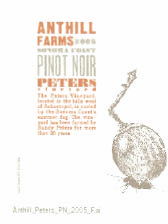 2004 Anthill Farms Peter’s Vineyard Sonoma Coast Pinot Noir 14.6% alc., 52 cases, $35. Randy Peters and father-in-law Tom Mukaida farm this vineyard located just outside Sebastopol in western Sonoma County. The vines were planted over 15 years ago on a steep, east-facing slope of goldridge soils. Clones are Pommard and 777. · The aromatics are very alluring featuring cherry wood and a hint of red Jolly Rancher. The black cherry core of flavors is enhanced by a subtle kiss of mocha. Finesse is the key word here as the wine flows smoothly over the palate and finishes cleanly with a trace of oak and a kick of acid. Like all good Pinots, it gains in the glass over time and is still good the next day. This one was kissed by an angel.
2004 Anthill Farms Demuth Vineyard Anderson Valley Pinot Noir 14.4% alc., 123 cases, $35. This venerable vineyard is now over 20 years old. At 1,400 to 1,600 feet above the valley floor near Boonville, it is exposed to strong winds and cool nights. The clones are Pommard and Wädenswil. Yields are ridiculously low. · The accessible nose exhibits dried cherry and floral notes with anise playing a role with air time. The flavors are a symphony of sweet cherries and minerality. A great acid spine portends a long life ahead.
For the 2005 vintage, Anthill Farms has recently released five Pinot Noirs: Abbey-Harris Vineyard (25 cases, $46, sold out) and Demuth Vineyard (102 cases, $38) in the Anderson Valley, Peter’s Vineyard (134 cases, $36) and Tina Marie Vineyard (210 cases, $43) in the Sonoma Coast, and Comptche Ridge Vineyard (75 cases, $36) in the northern Mendocino County coast. Anthill Farms Winery is located at 4791 Dry Creek Road, #3-4, Healdsburg, CA 95448. The phone is 707-490-5191. The 2005 Pinot Noirs may be ordered now online at www.anthillfarms.com.

2004 Brogan Cellars Summa Vineyard Young Vines Sonoma Coast 14.1% alc., $60. · This is a deep dark purple Pinot Noir that draws you in with a sumptuous dark cherry and toasty oak aromas. The lush fruit fills the mouth and the outrageous finish is brimming with dark cherries and spice. This is a brilliantly crafted and regal wine.
Brogan Cellars is located at 3232 B Dry Creek Rd B, Healdsburg, CA 95448. The phone is 707-473-0211. The website is www.brogancellars.com. Tasting is by appointment. The wines are sold through a mailing list.

 2005 Elke Vineyards Blue Diamond Donnelly Creek Anderson Valley Pinot Noir 13.9% alc., 550 cases, $30. · Ripe strawberries are pronounced in the nose and on the palate. Pleasing mid palate elegance, persistence and length with dusty tannins and herbs on the finish. Burgundian-styled and very likeable.
Elke Vineyards also produces a price-friendly Pinot Noir under the “mary elke” label ($19). It is 100% Dijon 113 from the Donnelly Creek Vineyard. The wines are sold to restaurants and directly to consumers from the website at www.elkevineyards.com. Library wines are also offered for sale on the website. The phone is 707-246-7045.
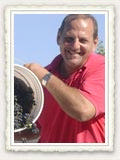
2005 Halleck Three Sons Cuvee Russian River Valley Pinot Noir 14.1% alc., 750 cases, $38. This wine is sourced from three vineyards: The Farm, Hallberg, and Hawk’s Roost. Clones are Dijon 115 and 777. The wine was aged in 30% new French oak for 10 months. · The aromatics are enticing with notes of cherry and toast and a kiss of anise. Light to medium in body, there is a well-constructed Bing cherry core of fruit all wrapped in a satiny sheet-like texture. There are some cola highlights also - more Pepsi than Coke. With laser-like clarity and balance, this Pinot is flat-out terrific.
For the 2005 vintage, the other Halleck Pinot Noirs include 2005 Halleck The Farm Vineyard Russian River Valley Pinot Noir (270 cases, $55), and the 2005 Halleck Hallberg Vineyard Russian River Valley Pinot Noir ($55). The 2004 Halleck Estate Russian River Valley Pinot Noir ($75) is still available. Halleck Vineyard wines are sold primarily through a mailing list. Sign up at www.halleckvineyard.com. There is limited retail distribution of some Pinot Noirs (for example, www.wallywine.com).
The history of Joseph Swan Vineyards has been told in some detail in past issues of the PinotFile. Founder Joseph Swan’s brother-in-law, Rod Berglund, has been the long-time winemaker here. Rod crafts consistently excellent Pinot Noirs and Zinfandels from an estate vineyard on Laguna Road, as well as other vineyard partners in the Russian River Valley.
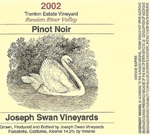 2004 Joseph Swan Vineyards Cuvee da Trois Russian River Valley Pinot Noir 13.6% alc., $23. · This Pinot is a real charmer with terrific aromatics of raspberry, tea, and spices. It is a wine of finesse and is light on its feet. No alcohol or tannin onslaught here. You just won’t find a better Pinot Noir for this price anywhere.
Joseph Swan Vineyards has a tasting room at the winery, 2916 Laguna Rd, Forestville, CA 95436, which is open on weekends. Wine may also be ordered on the website at www.swanwinery.com. The phone is 707-573-3747.
Founder Jess Jackson, a lawyer by training, made his first wine under the Kendall- Jackson label in 1982. His Chardonnay rode the wave of popularity of Chardonnay and the winery has been hugely successful. Kendall-Jackson now farms 12,000 acres of grapes in California. The winemaking team is headed by Randy Villom, with Pat Pickett, who was trained at Chalone and Estancia, directing the Pinot Noir production. The Highland Estates series focus on unique estate properties on ridges, hillsides, and bench lands
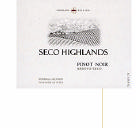 2003 K-J Highland Estates Seco Highlands Arroyo Seco Pinot Noir 14.5% alc., $33. · The aromatics are attractive with hi-tone cherries and spice. The flavors serenade with pleasing cherries, berries, and Asian spice. The texture is soft and oily. Over time, the wine picks up intensity with a more saturated cherry core, toast highlights, and more body. Very decent.
Kendall-Jackson Estates wines are in wide retail distribution. The 2005 vintage of this Pinot Noir is available on the website at www.kj.com.
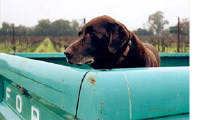
2004 Green Truck Cellars Napa Valley Pinot Noir 13.9% alc., $37. · This is a crisp and bright Pinot Noir powered by lively acidity. A little coffee and toast in the nose and a little spice on the finish. A very “juicy” wine that is looking for food. No complaints from me here.
2005 Green Truck Cellars Napa Valley Pinot Noir 13.8% alc., 600 cases, $38 (sold out on website). Aged in 80% new French and 20% new Hungarian oak in caves for one year. · A nice cherry core with toasty oak, spice and earthiness in both the nose and on the palate. The finish is tangy with deft oak highlights. It is beautifully balanced.
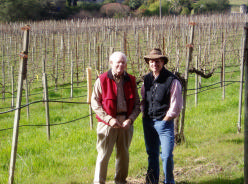 Green Truck Cellars Pinot Noirs are sold primarily through a mailing list a www.greentruckcellars.com. Kent also writes a terrific Pinot blog. The phone is 707-738-2376. Tasting is available by appointment.
2005 Pali Wine Co Shea Vineyard Willamette Valley Pinot Noir 14.0% alc., 249 cases, $44, screw cap. I looked and looked and could not find a vintage dating on the front or back label! · The aromas of fresh baked cherry pie wafted from the glass. There was a solid sweet red and black fruit core with judicious use of oak. Silky in texture, the finish left a lingering impression of dark chocolate, black cherries and lively acidity. There is a lot of charisma in this Pinot Noir.
Pali Wine Co is located at 1601 W Central Ave, F2, Lompoc, CA 93936. The phone is 805-736-7200. The wines are available retail.
2005 Mossback Russian River Valley Pinot Noir (?alc. - couldn’t find on label), $26. This wine won a Gold Medal at the recent Sonoma Harvest event. · This is a very nice example of Russian River Valley Pinot Noir. Sandalwood and red cherries perfume the wine leading to plenty of Bing cherry, coca-cola, and exotic spices. Very light on its feet, this Pinot finishes smoothly and clean. The whole package is nicely balanced. Nothing old-fashioned about this one.
 2004 Renteria Knittel Vineyard Carneros Pinot Noir 14.8% alc., 420 cases, $25. · This wine shows very nice aromatics that include cherry and rhubarb, spice, a kiss of oak, and a hint of alcohol. The red fruit flavors of raspberry, pomegranate, and cherry are highlighted by adroit use of oak. The taut tannins add to a full mouth feel. Well-made and recommended.
Renteria Wines are located at 1106 Clark St, Napa CA 94559. The phone is 707-253-7686. Wines may be ordered on line at www.renteriawines.com. There is a mailing list.

2005 Sanctuary Bien Nacido Vineyard Santa Maria Valley Pinot Noir 13.9% alc., 1,800 cases, $36. · I was taken by the gorgeous deep ruby color of this wine. The nose is earthy and filled with decomposing wet leaves. The dark stone fruits create a weighty mouth feel, and earthiness, cigar box and toasty oak add intrigue. Like the 2004 vintage of this wine, this a very distinctive Pinot which is a treat to drink.
Sanctuary wines are distributed primarily to restaurants. E-mail brand manager Tom Dempsey at Tom_Dempsey@b-f.com to locate the wine through retail channels. An online store will be available soon.
John Tracy of Owl Ridge Wine Services has about 34 winery clients at his facility in the old Vacu-Dry plant on Gravenstein Highway in Sebastopol. Tracy’s own labels are Owl Ridge Wines and its companion label, Willowbrook Cellars. The winemaker is Joe Otos. Pinot Noir grapes are sourced from the Owl Ridge Vineyard in Forestville, the Dutton Morelli Vineyard in the Russian River Valley and the Kastania Vineyard in Petaluma. 
2004 Willowbrook Cellars Dutton Morelli Vineyard Russian River Valley Pinot Noir 14.4% alc., 334 cases, $38. The Dutton Morelli Vineyard sits at 900 feet above the town of Occidental, positioned to avoid most of the fog and yet receive the cool breezes from the Pacific Ocean. The clone is Pommard. · The wine is aromatically gifted with dried cherry, cranberry and floral notes. Medium-bodied and elegant in style, the mélange of red and black fruits are enhanced with herbal and oak flavors. A Gold Medal winner at the 2006 Sonoma County Harvest Fair, this is a quality Pinot.
Willowbrook Cellars wines can be purchased from the website at www.willowbrookcellars.com. The phone is 707-823-0149. Tasting by appointment.
Pinot Noir EventsThe Carneros Heritage Fest takes place on June 1 and 2. Hosted by the Carneros Wine Alliance and co-hosted by The Donum Estate and Buena Vista Carneros, the Fest features a weekend of activities showcasing the Carneros region’s acclaimed wines, exceptional cuisine, unique history, and rustic environs. On Friday, June 1 there are intimate multi-course dinners hosted by renowned wineries and restaurants throughout the region. Artisan lamb dishes will be paired with Carneros wines . The dinners this year are: Acacia and Beaulieu Vineyards at Acacia Winery, Buena Vista Carneros at The Carneros Inn, Ceja Vineyards at Sienna Restaurant/Meritage Hotel (Napa), Etude Wines at Carneros Bistro/Lodge at Sonoma, Gloria Ferrer partnering with Sabor of Spain at Gloria Ferrer, MacRostie Winery partnering with Harvest Moon Café at Harvest Moon and Schug Carneros Estate at The General’s Daughter. Cost is $120 per person. On Saturday, June 2 there will be the first-ever “Taste of Carneros” lamb cook-off that will test the culinary talents of 12 local chefs in a competition to create the region’s most tantalizing lamb recipes. Chefs will serve up bite-sized samples for ticket buyers and a panel of celebrity and media wine and food experts will judge the samples. Live music, entertainment, demonstrations of sheep herding and falconry, vineyard tours, and marsh and environmental activities and tours will also be featured. A “Picnic in the Pasture” at The Donum Estate will pair Carneros wines with a lamb barbecue. Tickets are a very reasonable $75 per person. For information and to obtain tickets call 707-253-2678 or visit the Carneros Wine Alliance website at www.carneros.com. Proceeds from the Fest will support Vineyard Worker Services programs in Napa and Sonoma counties and Napa and Sonoma Farm Bureau “Ag in the Classroom” programs.
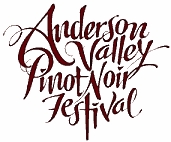 The 10th Annual Anderson Valley Pinot Noir Festival will be held May 18 to May 20. Friday, May 18 there is a day-long Technical Conference focused on the growing and making of Pinot Noir in vineyards and wineries on the Pacific Coast. Many winemakers and growers will present their views. Steve Heimoff, West Coast Editor of Wine Enthusiast Magazine, will speak as well. Tickets are $100. After the Conference there is a barbecue at Navarro Vineyards ($45). The Grand Tasting of Anderson Valley wines is on Saturday, May 19 under the big tent at Goldeneye Winery in Philo. 34 wineries will be pouring. A silent auction will be held to benefit local Anderson Valley charities. Tickets are $85. Saturday evening there are several Winemaker Dinners at notable Mendocino restaurants. Examples are: Navarro Vineyards and Philo Ridge Vineyards at Little River Inn and Claudia Springs Winery, Goldeneye Winery, Harmonique Pinot Noir and Lazy Creek Vineyards at The Heritage House. Tickets are $150. Finally, if you are still eager, on Sunday, May 20, there are free open houses at host wineries throughout the Anderson Valley. For information and tickets, phone 707-895-WINE or go online to www.avwines.com.
Overheard from a Goombah deriding Pinot NoirI am disturbed by the way people have cast aside their strong Roman blood-line for that weak and faggoty French-perfumed grape. One should be proud of their Italian heritage and the manly wines that come from their country of origin. Your grandparents are undoubtedly rolling over in their graves at the way you have dismissed the great wines of Italy. You should never be ashamed to drink Italian. That should be your motto. You should ask your family, past and present, to forgive your transgression and never grovel to this false God, the Prince of Pinot. Repent now before it is too late or you will be denied permission to ever again enter the country of Italy!
Burghound’s First 100 Point Wine RumoredAllen Meadows (aka Burghound) is one of the world’s authorities on Burgundy. He is known to be stingy with scores above 94. His Burghound newsletter (www.burghound.com) provides extensive notes on Burgundies that most of us can only dream about tasting. The 1945 Domaine Romanee-Conti Romanee-Conti is a legendary red Burgundy. Allen often points out that while only 608 bottles of this wine were produced, over 40,000 bottles have claimed to have been drunk! He also points out that “La Tache comes to you and seduces you, Romanee-Conti makes you come to it; it doesn’t care.” John Kapon of Acker-Merrill-Condit wine auctioneers and retailers in New York, also tastes many older vintages of Burgundy, as part of his “job” of insuring older bottles of Burgundy to be auctioned are pristine. He has drunk the 1945 DRC Romanee-Conti and claims it is the “best wine that I have ever had.” In New York City recently, a Romanee-Conti tasting was held over four days, and Aubert de Villaine was in attendance. John Kapon reports that the older vintages of this wine showed extremely well. There were rumors being spread through the City after this event that the 1945 DRC Romanee-Conti was the Burghound’s first 100 point wine. |